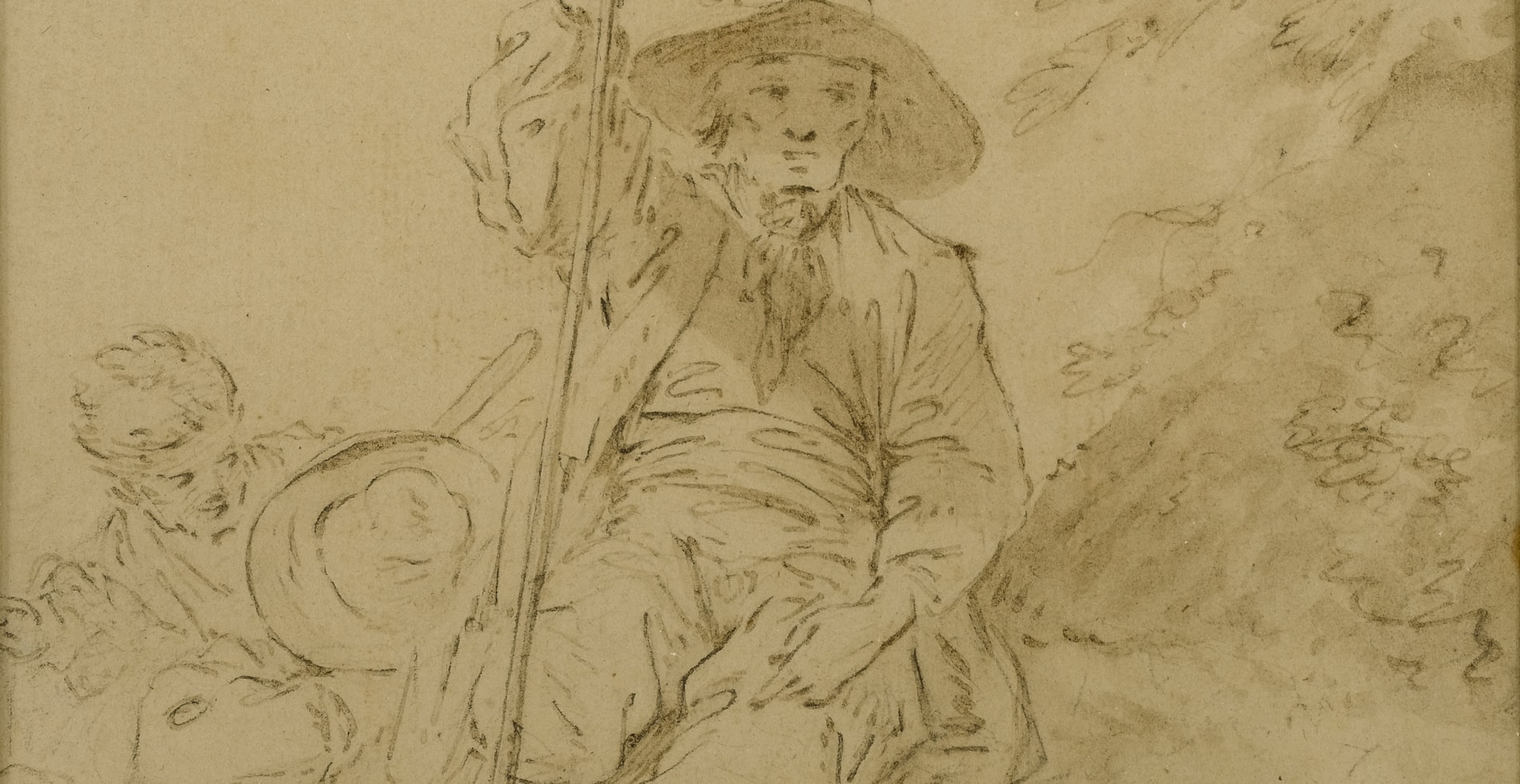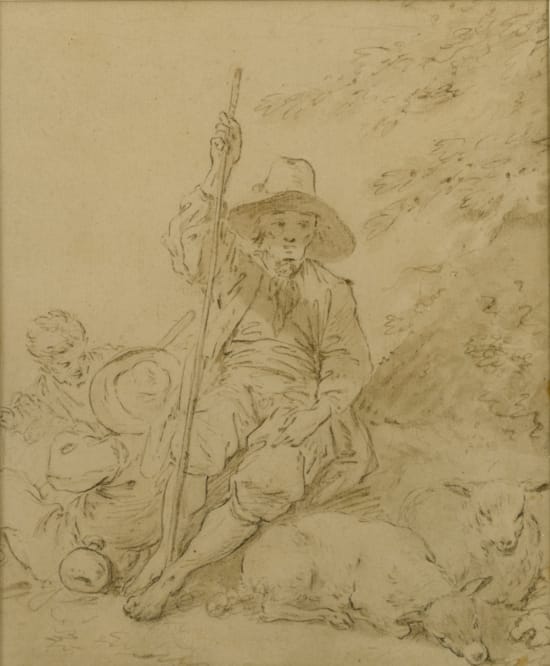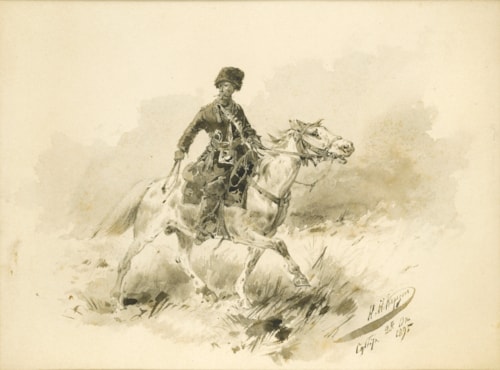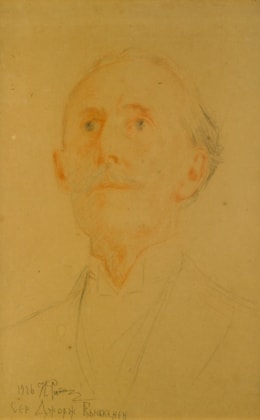ean-Baptiste Le Prince
(Metz 1734 - Saint-Denis-du-Port 1781)
A Shepherd Resting, Two Figures Behind
black chalk, pen and brown ink, brown wash, on paper
16.8 x 14 cm (6⅝ x 5½ in)
In this charming image of rural life, a shepherd rests on a grassy bank watching his sleeping flock. This central figure appears weary, and is still clutching his staff for support, his exhausted state is mirrored by his animals, although in contrast the two figures behind him appear younger and more animated. Jean-Baptiste Le Prince has focused on his subject’s appearance, emphasising the rustic nature of the figure. The shepherd is barefooted and wears worn, practical clothing with a wide-brimmed hat to protect him from the sun, the sort of rural figure who recurs throughout Le Prince’s work. Le Prince has used a wash to achieve the effect of shadow in the work and this anticipates the use of aquatint in his prints, a technique which achieves an appearance of wash, of which Le Prince was a pioneer.
In terms of subject A Shepherd Resting, Two Figures Behind is reminiscent of one of Le Prince’s highly successful prints, La Jeune Bergere. The central figure in this work is female but she too is resting beneath a tree, with her herd around her. Just as there is a clear focus on the central figure and his dress in the present work, so Le Prince has provided a detailed study of the exotic costume of the young shepherdess. The central figure in the present drawing recurs in many of Le Prince’s rural scenes. For example a very similar figure can be seen in the Courtauld Gallery’s Landscape with Herdsman and Cattle. The figures in both works wear very comparable peasant clothing and the same distinctive hat. Both works demonstrates Le Prince’s exceptional technique as a draughtsman and his ability to combine different types of wash and line, to create varied and detailed works.
Le Prince, a pupil of François Boucher (1703-1770), became famous for his charming genre scenes of Russian rural life, as well as his pioneering role in the use of aquatint. He travelled extensively throughout Russia between 1757 and 1762, making many sketches of daily Russian life, and receiving multiple commissions from Empress Elizabeth (1709-1762) and Peter III (1728-1762). His numerous sketches, which usually focused on peasant life, from his time in Russia provided the basis for the majority of his work when he returned to France. His genre scenes, both in oil and in print, were extremely popular and much acclaimed in France, not only because of their skilful execution, but also because their exoticism conformed to contemporary tastes. As Kimerley Rorschach comments ‘Repeated in paintings, drawings, prints, and tapestries, Le Prince’s images brought the exotic flavour of far-away Russian into the drawing rooms of many a fashionable Frenchman.’
In this charming image of rural life, a shepherd rests on a grassy bank watching his sleeping flock. This central figure appears weary, and is still clutching his staff for support, his exhausted state is mirrored by his animals, although in contrast the two figures behind him appear younger and more animated. Jean-Baptiste Le Prince has focused on his subject’s appearance, emphasising the rustic nature of the figure. The shepherd is barefooted and wears worn, practical clothing with a wide-brimmed hat to protect him from the sun, the sort of rural figure who recurs throughout Le Prince’s work. Le Prince has used a wash to achieve the effect of shadow in the work and this anticipates the use of aquatint in his prints, a technique which achieves an appearance of wash, of which Le Prince was a pioneer.
In terms of subject A Shepherd Resting, Two Figures Behind is reminiscent of one of Le Prince’s highly successful prints, La Jeune Bergere. The central figure in this work is female but she too is resting beneath a tree, with her herd around her. Just as there is a clear focus on the central figure and his dress in the present work, so Le Prince has provided a detailed study of the exotic costume of the young shepherdess. The central figure in the present drawing recurs in many of Le Prince’s rural scenes. For example a very similar figure can be seen in the Courtauld Gallery’s Landscape with Herdsman and Cattle. The figures in both works wear very comparable peasant clothing and the same distinctive hat. Both works demonstrates Le Prince’s exceptional technique as a draughtsman and his ability to combine different types of wash and line, to create varied and detailed works.
Le Prince, a pupil of François Boucher (1703-1770), became famous for his charming genre scenes of Russian rural life, as well as his pioneering role in the use of aquatint. He travelled extensively throughout Russia between 1757 and 1762, making many sketches of daily Russian life, and receiving multiple commissions from Empress Elizabeth (1709-1762) and Peter III (1728-1762). His numerous sketches, which usually focused on peasant life, from his time in Russia provided the basis for the majority of his work when he returned to France. His genre scenes, both in oil and in print, were extremely popular and much acclaimed in France, not only because of their skilful execution, but also because their exoticism conformed to contemporary tastes. As Kimerley Rorschach comments ‘Repeated in paintings, drawings, prints, and tapestries, Le Prince’s images brought the exotic flavour of far-away Russian into the drawing rooms of many a fashionable Frenchman.’





 contact
contact contact
contact +44 20 7313 8040
+44 20 7313 8040









